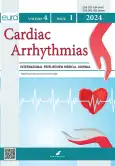First experience of treating patients with atrial fibrillation using thoracoscopic isolation with left atrial appendage excision in the North-Western State Medical University named after I.I. Mechnikov
- Authors: Yakovlev D.A.1, Lenkin A.I.1, Stepanova V.V.1, Marinin V.A.1, Petrov N.V.1, Verendeev V.K.1
-
Affiliations:
- North-Western State Medical University named after I.I. Mechnikov
- Issue: Vol 4, No 1 (2024)
- Pages: 15-22
- Section: Case reports
- URL: https://journals.rcsi.science/cardar/article/view/257368
- DOI: https://doi.org/10.17816/cardar625555
- ID: 257368
Cite item
Abstract
The given article describes the first experience of a thoracoscopic isolation of pulmonary veins and left atrial appendage excision in the North-Western State Medical University named after I.I. Mechnikov. The clinical case features a woman with a long history of paroxysmal atrial fibrillation, severe left atrium dilation, failure in a pace control drug therapy and no effect of radiofrequency catheter isolation of pulmonary veins.
Additionally, there outlined the advantages and the significance of employing the method of thoracoscopic ablation in patients with symptomatic paroxysmal and long-term persistent atrial fibrillation, — in case if antiarrythmic drugs and radiofrequency catheter ablation proved ineffective, as well as in patients with a long-term persistent atrial fibrillation along with a severe left atrium dilation.
Full Text
##article.viewOnOriginalSite##About the authors
Dmitrii A. Yakovlev
North-Western State Medical University named after I.I. Mechnikov
Author for correspondence.
Email: dmitrii.yakovlev@szgmu.ru
ORCID iD: 0000-0002-1994-8470
SPIN-code: 5422-3296
MD, Cand. Sci. (Med.), cardiovascular surgeon, assistant at the department of surgery
Russian Federation, Saint PetersburgAndrey I. Lenkin
North-Western State Medical University named after I.I. Mechnikov
Email: Andrei.Lenkin@szgmu.ru
ORCID iD: 0000-0003-3099-9276
SPIN-code: 4155-0635
MD, Dr. Sci. (Med.), Assistant Professor
Russian Federation, Saint PetersburgVera V. Stepanova
North-Western State Medical University named after I.I. Mechnikov
Email: veragrokhotova@mail.ru
ORCID iD: 0000-0003-2540-6544
SPIN-code: 9710-3406
MD, Cand. Sci. (Med.), cardiovascular surgeon
Russian Federation, Saint PetersburgValeriy A. Marinin
North-Western State Medical University named after I.I. Mechnikov
Email: marininva@mail.ru
ORCID iD: 0000-0002-8141-5149
SPIN-code: 3681-6714
MD, Dr. Sci. (Med.), cardiovascular surgeon
Russian Federation, Saint PetersburgNikolai V. Petrov
North-Western State Medical University named after I.I. Mechnikov
Email: npeval@yandex.ru
ORCID iD: 0009-0009-1477-4879
cardiovascular surgeon
Russian Federation, Saint PetersburgVladislav K. Verendeev
North-Western State Medical University named after I.I. Mechnikov
Email: verendeev02@mail.ru
ORCID iD: 0000-0003-4720-4476
medical student
Russian Federation, Saint PetersburgReferences
- Ariss R, Minhas A, Patel N, et al. Contemporary trends and in-hospital outcomes of catheter and stand-alone surgical ablation of atrial fibrillation. Europace. 2022;24(2):218–225. doi: 10.1093/europace/euab198
- Belluschi I, Lapennaa E, Carino D, et al. Long-term results of thoracoscopic ablation of paroxysmal atrial fibrillation: is the glass half full or half empty? Eur J Cardiothorac Surg. 2021;60(4):850–856. doi: 10.1093/ejcts/ezab138
- Haldar S, Khan H, Boyalla V, et al. Catheter ablation vs. thoracoscopic surgical ablation in long-standing persistent atrial fibrillation: CASA-AF randomized controlled trial. Eur Heart J. 2020;41(47):4471–4480. doi: 10.1093/eurheartj/ehaa658
- Vos L, Bentala M, Geuzebroek G, et al. Long-term outcome after totally thoracoscopic ablation foratrial fibrillation. J Cardiovasc Electrophysiol. 2020;3(1):40–45. doi: 10.1111/jce.14267
- Kubota H, Ohtsuka T, Ninomiya M, et al. Thoracoscopic infrared ablation to create a box lesion as a treatment for atrial fibrillation. J Cardiothorac Surg. 2022;17(1):1. doi: 10.1186/s13019-021-01750-1
- Buqing Ni, Zidun W, Weidong G, et al. Thoracoscopic Left Atrial Appendage Excision Plus Ablation for Atrial Fibrillation to Prevent stroke. Semin Thorac Cardiovasc Surg. 2021;33(1):61–67. doi: 10.1053/j.semtcvs.2020.06.041
- Hindricks G, Potpara T, Dagres N, et al. 2020 ESC Guidelines for the diagnosis and management of atrial fibrillation developed in collaboration with the European Association for Cardio-Thoracic Surgery (EACTS): The Task Force for the diagnosis and management of atrial fibrillation of the European Society of Cardiology (ESC) Developed with the special contribution of the European Heart Rhythm Association (EHRA) of the ESC. Eur Heart J. 2021;42(5): 373–498. doi: 10.1093/eurheartj/ehaa612
- Krivosheev Y, Bashta D, Simonyan A, et al. Ablation of ganglionic plexuses combined with pulmonary vein isolation after drug testing of «hidden» atriovenous conduction with exclusion of extrapulmonary triggers in patients with paroxysmal atrial fibrillation. Patologiya krovoobrashcheniya i kardiokhirurgiya. 2018;22(3):25–38. (In Russ.) EDN: VLVAWO doi: 10.21688-1681-3472-2018-3-25-38
- Wolf R, Schneeberger E, Osterday R, et al. Video-assisted bilateral pulmonary vein isolation and left atrial appendage exclusion for atrial fibrillation. J Thorac Cardiovasc Surg. 2005;130(3):797–802. doi: 10.1016/j.jtcvs.2005.03.041
- Kwon HJ, Jeong D, Park SJ, et al. Long-term outcome of totally thoracoscopic surgical ablation in atrial fibrillation: A single-center experience. Int J Cardiol Heart Vasc. 2021;36:100861. doi: 10.1016/j.ijcha.2021.100861
- On YK, Jeong DS. Updates in hybrid AF ablation: a hybrid approach to surgical epicardial ablation and cather endocardial ablation in persistent atrial fibrillation. Int J Arrhythm. 2022;23(5):1–9. doi: 10.1186/s42444-021-00056-6
- Revishvili A, Taimasova I, Artyukhina E, et al. Mid-term outcomes of thoracoscopic and hybrid therapy of atrial fibrillation. Journal of Arrhythmology. 2021;28(3):5–12. (In Russ.) EDN: PVNCAU doi: 10.35336/VA-2021-3-5-12
- Petersen J, Pecha S. What we need to do so that the glass is more than half full in stand-alone thoracoscopic ablation. Eur J Cardiothorac Surg. 2021;60(4):857–858. doi: 10.1093/ejcts/ezab351
- Lyashenko V, Ivanchenko A, Postol A, et al. Recurrence of arrhythmias after thoracoscopic MAZE procedure. Cardiac Arrhythmias. 2023;3(2):5–16. doi: 10.17816/cardar492331
- Pong T, Shah R, Carlton C, et al. Hybrid ablation for atrial fibrillation: safety & efficacy of unilateral epicardial access. Semin Thorac Cardiovasc Surg. 2023;35(2):277–286. doi: 10.1053/j.semtcvs.2022.03.003
- Kim J, Jeong D, Kwon HJ, et al. Effectiveness of the early staged hybrid approach for treatment of symptomatic atrial fibrillation: the electrophysiology study could be deferred? J Korean Med Sci. 2021;36(43):e276. doi: 10.3346/jkms.2021.36.e276
Supplementary files











